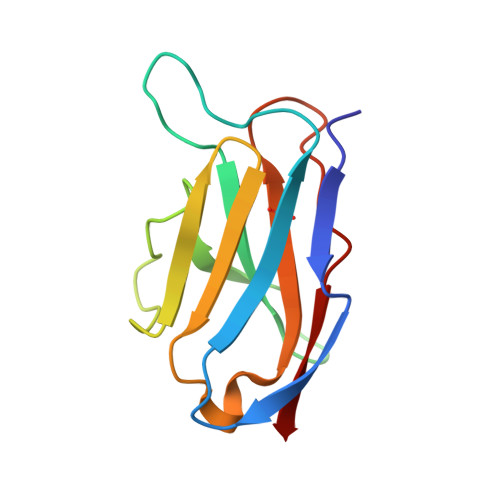Structural basis for amide hydrolysis catalyzed by the 43C9 antibody.
Thayer, M.M., Olender, E.H., Arvai, A.S., Koike, C.K., Canestrelli, I.L., Stewart, J.D., Benkovic, S.J., Getzoff, E.D., Roberts, V.A.(1999) J Mol Biol 291: 329-345
- PubMed: 10438624
- DOI: https://doi.org/10.1006/jmbi.1999.2960
- Primary Citation of Related Structures:
43C9, 43CA - PubMed Abstract:
Among catalytic antibodies, the well-characterized antibody 43C9 is unique in its ability to catalyze the difficult, but desirable, reaction of selective amide hydrolysis. The crystallographic structures that we present here for the single-chain variable fragment of the 43C9 antibody, both with and without the bound product p -nitrophenol, strongly support and extend the structural and mechanistic information previously provided by a three-dimensional computational model, together with extensive biochemical, kinetics, and mutagenesis results. The structures reveal an unexpected extended beta-sheet conformation of the third complementarity determining region of the heavy chain, which may be coupled to the novel indole ring orientation of the adjacent Trp H103. This unusual conformation creates an antigen-binding site that is significantly deeper than predicted in the computational model, with a hydrophobic pocket that encloses the p -nitrophenol product. Despite these differences, the previously proposed roles for Arg L96 in transition-state stabilization and for His L91 as the nucleophile that forms a covalent acyl-antibody intermediate are fully supported by the crystallographic structures. His L91 is now centered at the bottom of the antigen-binding site with the imidazole ring poised for nucleophilic attack. His L91, Arg L96, and the bound p -nitrophenol are linked into a hydrogen-bonding network by two well-ordered water molecules. These water molecules may mimic the positions of the phosphonamidate oxygen atoms of the antigen, which in turn mimic the transition state of the reaction. This network also contains His H35, suggesting that this residue may also stabilize the transition-states. A possible proton-transfer pathway from His L91 through two tyrosine residues may assist nucleophilic attack. Although transition-state stabilization is commonly observed in esterolytic antibodies, nucleophilic attack appears to be unique to 43C9 and accounts for the unusually high catalytic activity of this antibody.
Organizational Affiliation:
Department of Molecular Biology, The Scripps Research Institute, La Jolla, CA, 92037, USA.
















